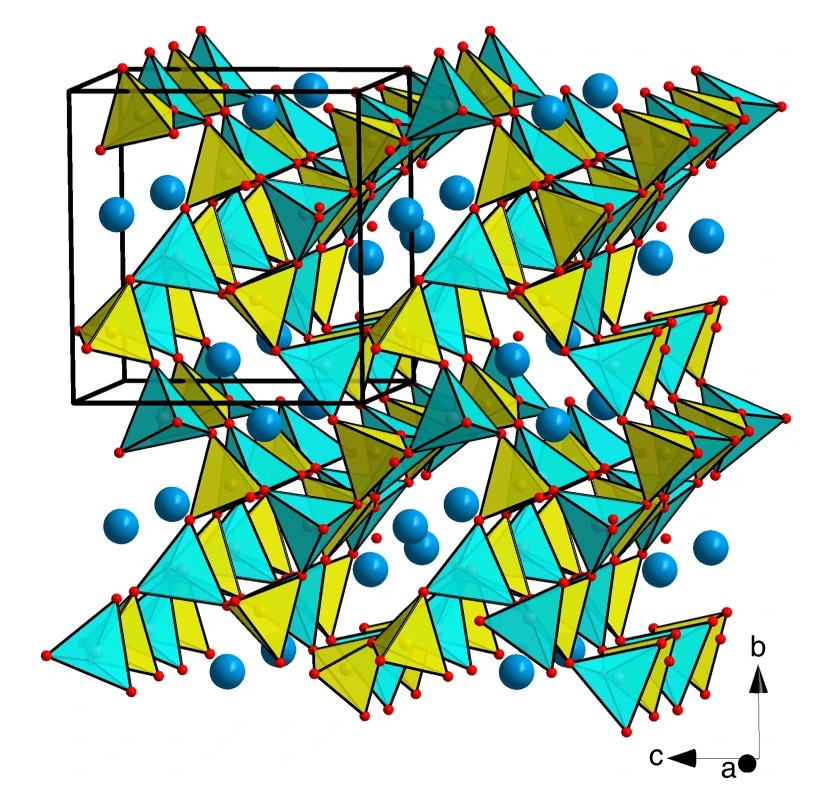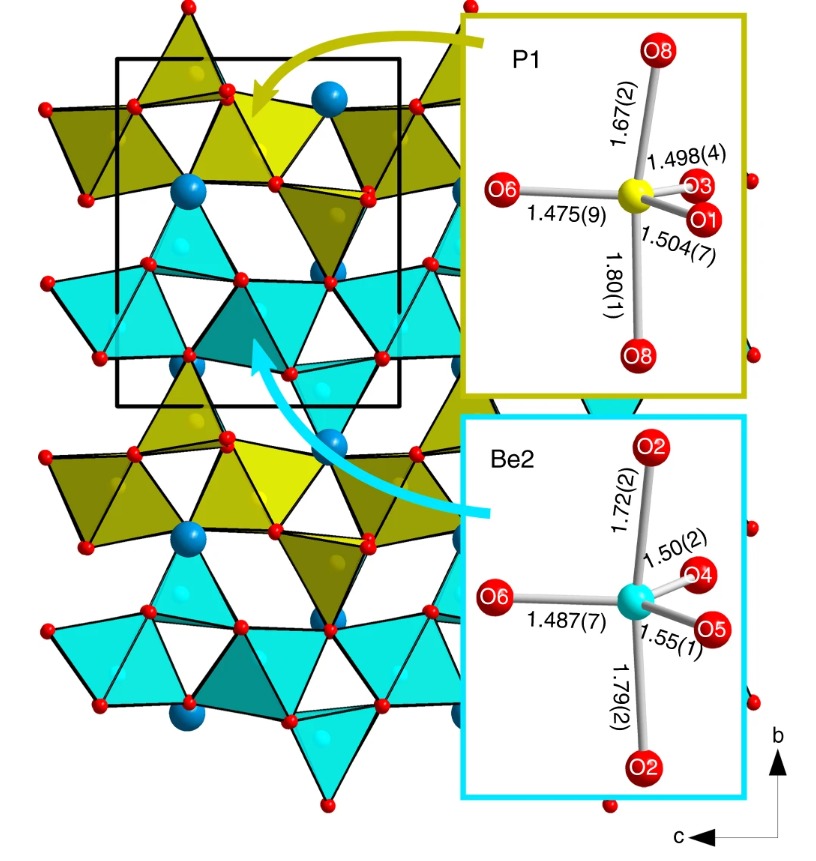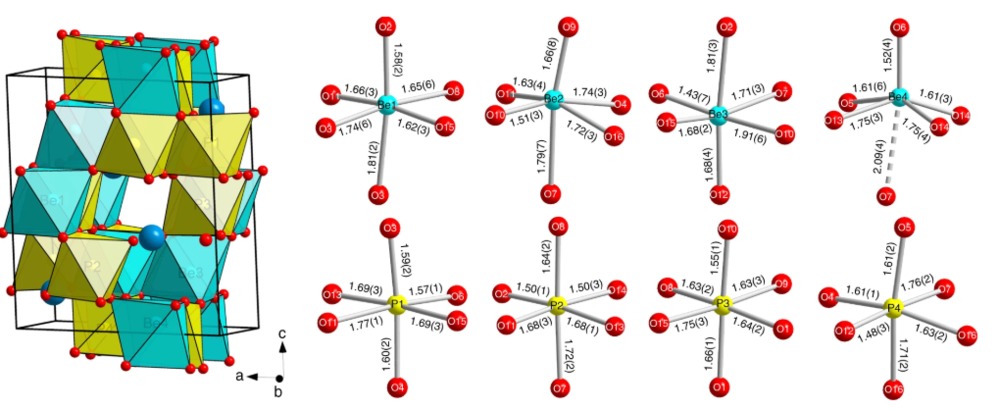How we discovered material modifications that contradict established chemical principles
Scientists of NUST “MISiS” together with Russian and foreign colleagues have proved the possibility of creating materials that are unrealistic from the point of view of the usual understanding of the laws of chemistry. Having exposed beryllium oxide to a pressure hundreds of thousands of times higher than atmospheric, the researchers achieved a “periorientation” of the crystalline structure of the material to five and six oxygen atoms surrounded by beryllium, although it was previously believed that the maximum possible number could be only four. The results of the experiment and its theoretical justification, scientists presented in the journal Nature Communications.
Imagine that you have a mountain of cubes in front of you, and you are going to build something from them, the authors of the study describe their work. -You can assemble quite a lot of various designs, but still their number is limited due to the shape of the “building materials”, because they can only be connected to each other in a certain way. Now imagine that you have the opportunity to change the shape of these cubes - stretch them, add faces, in a word, modify them in such a way that the number of possible combinations of the resulting “building materials” increases by an infinite number of times.

Head of the laboratory I. Abrikosov (left) with employees.
The cubes in question are nothing more than elements of the crystalline structure of materials, by modifying which, you can “award” materials with fundamentally new properties. But certain transformations are impossible within the framework of familiar notions.
Scientists from NUST MISiS together with colleagues from the University of Bayreuth and DESY Research Center (Germany), Linköping University (Sweden), as well as the Russian Academy of Sciences (Institute of Earth Sciences and the Kola Science Center) are solving this problem - overcoming "impossibility". )
As shown by the results of their joint research - a laboratory experiment and its theoretical modeling - obtaining "impossible" modifications of materials is quite possible - and for this it is necessary to expose them to ultrahigh pressures, hundreds of thousands of times higher than atmospheric.

The tetrahedral coordinated beryllium oxide
“We worked with herlbutite, one of the forms of the combination of beryllium with the chemical formula CaBe2P2O8. Under classical conditions, it has a tetrahedral structure - beryllium forms tetrahedral pyramids with oxygen atoms, and until recently it was believed that this is the maximum possible coordination of beryllium. However, our colleagues from Germany conducted an experiment, as a result of which it turned out that the crystal structure can be rearranged. During the experiment, the material was placed in a diamond anvil, where it was exposed to ultrahigh pressures.

Five-sided coordinated beryllium oxide
So, at a pressure of 17 GPa (170 thousand terrestrial atmospheres), the number of oxygen atoms of the surrounding beryllium increased to five, and at a pressure of 80 GPa (800 thousand terrestrial atmospheres), the crystal was rebuilt so that this number increased to six. This is an incredible result, never before presented to anyone. That is why he needed a theoretical justification, the development of which we took up independently on our supercomputer , ”says Professor Igor Abrikosov , scientific director of the Laboratory for Modeling and Development of New Materials of NUST MISiS.

Hex Coordinated Beryllium Oxide
Theoretical modeling of the results of the experiment was carried out by scientists of NUST “MISiS” in record time - in just one month. To solve the Dirac equation with the given variables, all the computing power of the supercomputer cluster of the Laboratory “Modeling and Development of New Materials” was used. Without the use of such a supercomputer, it would never be possible to carry out calculations of such complexity - conventional computers would simply not have enough power. The calculation results almost completely coincided with the experimental results - the differences are minimal, and are within the permissible error margin.

Supercomputer NUST "MISiS"
As Professor Abrikosov notes, in many respects beryllium was chosen as an experimental material because it is especially popular in mechanical engineering and the space industry. Nevertheless, the work done is more fundamental in nature - by studying the modifications of specific materials, it is possible to build a general theoretical model that allows one to systematize the processes and conditions necessary to create “impossible materials”. In the immediate plans of scientists is to continue research, in particular, with such a class of materials as polynitrides.
Reference:
Professor Igor Abrikosov - Doctor of Philosophy, scientific director of the Laboratory “Modeling and Development of New Materials” NUST “MISiS”, head of the Department of Theoretical Physics of the Institute of Physics, Chemistry and Biology of Linkoping University, academician of the Royal Swedish Academy of Sciences.
The scientific group under his leadership is working on a theoretical modeling of the processes taking place in materials under conditions of high and ultrahigh pressures.
Previously, scientists have already proved the possibility of the existence of “unrealistic” modifications of silica and nitrides , as well as the transformation of a hematite insulator into a conductor - and all this at pressures of hundreds of thousands (and sometimes millions) above atmospheric.
Imagine that you have a mountain of cubes in front of you, and you are going to build something from them, the authors of the study describe their work. -You can assemble quite a lot of various designs, but still their number is limited due to the shape of the “building materials”, because they can only be connected to each other in a certain way. Now imagine that you have the opportunity to change the shape of these cubes - stretch them, add faces, in a word, modify them in such a way that the number of possible combinations of the resulting “building materials” increases by an infinite number of times.

Head of the laboratory I. Abrikosov (left) with employees.
The cubes in question are nothing more than elements of the crystalline structure of materials, by modifying which, you can “award” materials with fundamentally new properties. But certain transformations are impossible within the framework of familiar notions.
Scientists from NUST MISiS together with colleagues from the University of Bayreuth and DESY Research Center (Germany), Linköping University (Sweden), as well as the Russian Academy of Sciences (Institute of Earth Sciences and the Kola Science Center) are solving this problem - overcoming "impossibility". )
As shown by the results of their joint research - a laboratory experiment and its theoretical modeling - obtaining "impossible" modifications of materials is quite possible - and for this it is necessary to expose them to ultrahigh pressures, hundreds of thousands of times higher than atmospheric.

The tetrahedral coordinated beryllium oxide
“We worked with herlbutite, one of the forms of the combination of beryllium with the chemical formula CaBe2P2O8. Under classical conditions, it has a tetrahedral structure - beryllium forms tetrahedral pyramids with oxygen atoms, and until recently it was believed that this is the maximum possible coordination of beryllium. However, our colleagues from Germany conducted an experiment, as a result of which it turned out that the crystal structure can be rearranged. During the experiment, the material was placed in a diamond anvil, where it was exposed to ultrahigh pressures.

Five-sided coordinated beryllium oxide
So, at a pressure of 17 GPa (170 thousand terrestrial atmospheres), the number of oxygen atoms of the surrounding beryllium increased to five, and at a pressure of 80 GPa (800 thousand terrestrial atmospheres), the crystal was rebuilt so that this number increased to six. This is an incredible result, never before presented to anyone. That is why he needed a theoretical justification, the development of which we took up independently on our supercomputer , ”says Professor Igor Abrikosov , scientific director of the Laboratory for Modeling and Development of New Materials of NUST MISiS.

Hex Coordinated Beryllium Oxide
Theoretical modeling of the results of the experiment was carried out by scientists of NUST “MISiS” in record time - in just one month. To solve the Dirac equation with the given variables, all the computing power of the supercomputer cluster of the Laboratory “Modeling and Development of New Materials” was used. Without the use of such a supercomputer, it would never be possible to carry out calculations of such complexity - conventional computers would simply not have enough power. The calculation results almost completely coincided with the experimental results - the differences are minimal, and are within the permissible error margin.

Supercomputer NUST "MISiS"
As Professor Abrikosov notes, in many respects beryllium was chosen as an experimental material because it is especially popular in mechanical engineering and the space industry. Nevertheless, the work done is more fundamental in nature - by studying the modifications of specific materials, it is possible to build a general theoretical model that allows one to systematize the processes and conditions necessary to create “impossible materials”. In the immediate plans of scientists is to continue research, in particular, with such a class of materials as polynitrides.
Reference:
Professor Igor Abrikosov - Doctor of Philosophy, scientific director of the Laboratory “Modeling and Development of New Materials” NUST “MISiS”, head of the Department of Theoretical Physics of the Institute of Physics, Chemistry and Biology of Linkoping University, academician of the Royal Swedish Academy of Sciences.
The scientific group under his leadership is working on a theoretical modeling of the processes taking place in materials under conditions of high and ultrahigh pressures.
Previously, scientists have already proved the possibility of the existence of “unrealistic” modifications of silica and nitrides , as well as the transformation of a hematite insulator into a conductor - and all this at pressures of hundreds of thousands (and sometimes millions) above atmospheric.
